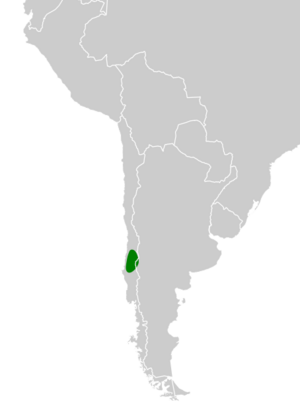Chestnut-throated huet-huet facts for kids
Quick facts for kids Chestnut-throated huet-huet |
|
|---|---|
 |
|
| Conservation status | |
| Scientific classification | |
| Genus: |
Pteroptochos
|
| Species: |
castaneus
|
 |
|
The chestnut-throated huet-huet (Pteroptochos castaneus) is a unique bird. It is a large songbird from the Rhinocryptidae family. This family is often called "tapaculos." The chestnut-throated huet-huet is one of the biggest birds in its family. It weighs about 165 grams (5.8 oz). This makes it one of the heaviest songbirds in its group.
This bird is quite stocky, meaning it has a strong, compact body. It is about 23 centimetres (9.1 in) long. Most of its feathers are dark brown. It has a special dark red throat. It also has a light buff bar on its wing. For many years, scientists debated if this bird was the same species as the black-throated huet-huet. But studies in the 1990s showed they are different species. They separated long ago, even before the big ice sheets formed in Chile.
Contents
Where the Chestnut-throated Huet-huet Lives
This bird lives in the temperate forests of Chile. You can find it mainly in the Biobío, Maule, and parts of O'Higgins regions. It also lives in a small area of Neuquén Province in Argentina. These forests have special trees like Nothofagus and Austrocedrus chilensis. The areas are usually humid, near the Mediterranean climate zone.
Sometimes, the huet-huet can be found in Pinus radiata tree farms. But only if these farms have a thick layer of shrubs underneath. This is because the bird needs dense plants to move around. A study of the fragmented Maulino forest showed this. It cannot cross open areas without thick undergrowth.
What the Chestnut-throated Huet-huet Eats
The chestnut-throated huet-huet eats mostly insects and their larvae. Larvae are young insects, like caterpillars. It also eats many seeds and fruits. It uses its long claws to dig for food on the forest floor. This bird might also help spread seeds for some forest plants. This means it helps new plants grow in different places.
Family Life of the Chestnut-throated Huet-huet
Breeding season for these birds is in spring. This is usually between September and December. They dig burrows to make their nests. They dig these burrows during the winter rainy season. The soil is softer then, making it easier to dig.
Their burrows can be as deep as 3 metres (9.8 ft). Inside the burrow, they lay two oval white eggs. These eggs are very large for the bird's size. They are typically about 35.6 millimetres (1.4 in) long and 27.9 millimetres (1.1 in) wide. Each egg weighs around 14 grams (0.5 oz). Scientists believe both the male and female birds sit on the eggs to keep them warm. This is common for birds in this group. However, how long the eggs take to hatch is not yet known.
The Huet-huet's Special Song
Huet-huets are famous for their calls and songs. The chestnut-throated huet-huet's song is a series of deep, ringing "hoots." Unlike its relatives further south, this bird often sings as a duet with its partner. Its song is higher, softer, and faster than the black-throated species. When it feels danger, its alarm call sounds like "wehk, wehk, wehk."


